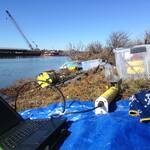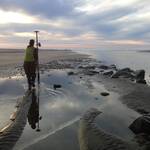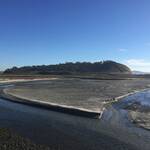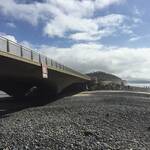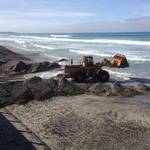With a grant from the California Department of Parks and Recreation Natural Resources Division – Coastal Program (“Estuary Inlet Dynamics & Analysis”, July 2017- December 2021) , our lab collaborated with Dr. Timu Gallien (UCLA, Coastal Flood Lab) to examine the interaction between estuary inlets and the adjacent beaches. We have collected fundamental hydraulic and hydrodynamic data and monitored evolving estuary inlets and adjacent beaches at two California State Parks, Torrey Pines/Los Peñasquitos Lagoon and Cardiff State Beach/San Elijo Lagoon (see Figure 1 & 2). Beaches were surveyed using real time kinematic surveying. Beach and estuary inlet shoreline and channel erosion data were collected using wading real time kinematic surveys and a Parks-funded UAV. Our high resolution subaerial inlet and adjacent beach topography provides improved, site specific inlet information that will help inform when park facilities or infrastructure may be impacted by inlet closures or large erosion events. Moreover, this data collection and analysis provides key data for future coupled inlet-beach morphological modeling elucidating infrastructure and ecological hazards associated with sea level rise and increased streamflow. Additionally, this research furthers understanding of two unstabilized, nourished beach-estuarine systems. Climate change will alter estuary-beach feedbacks and, in the future, these systems may require increased management (nourishment, breaching) and potentially stabilization.
A 2019 augmentation award focused on supporting additional observational collection, as well as preliminary development of a realistic wave-current coupled hydrodynamic simulation for the Torrey Pines/Los Peñasquitos Lagoon region.
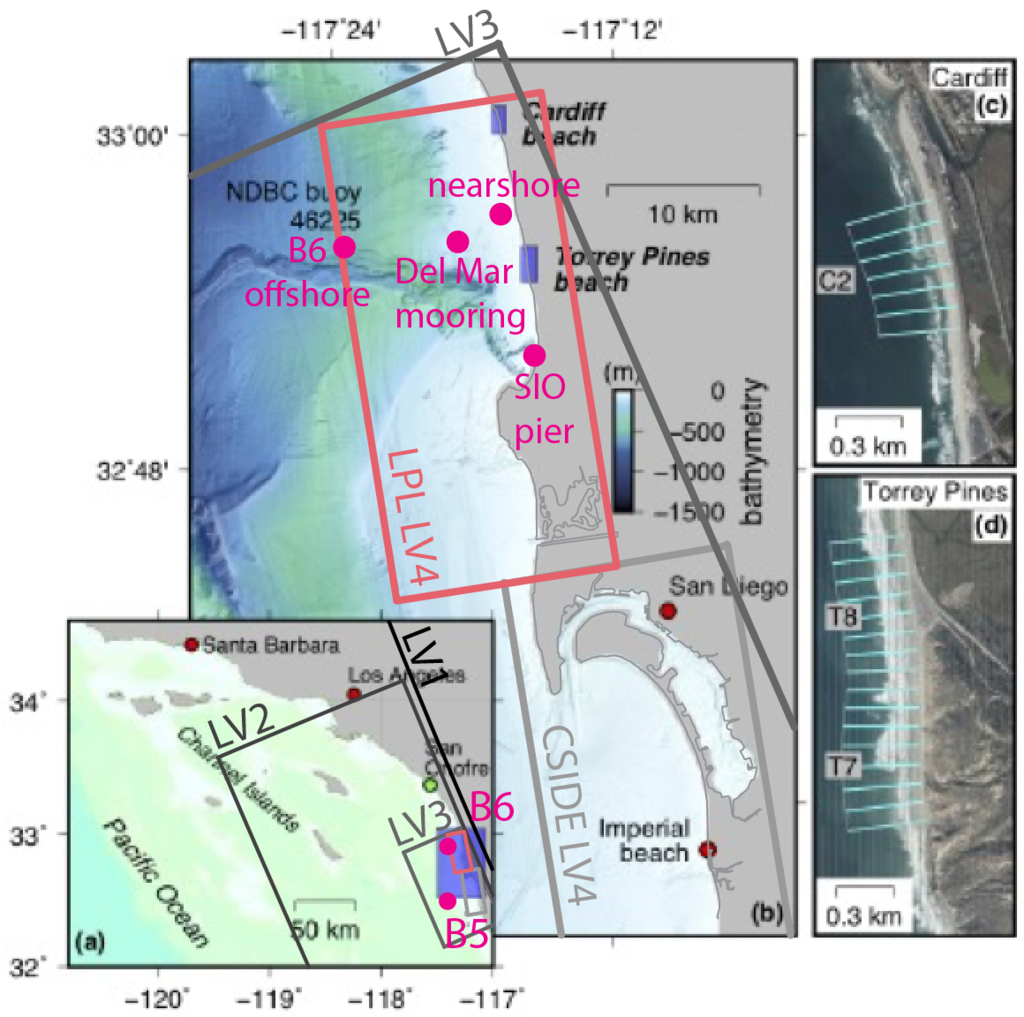
Figure 1. (b) Regional map with both locations indicated (c, d) Profiles for XBeach and CShore calibration and validation at each site (Kalligeris et al., 2020). The newly developed high resolution model domain (LPL LV4), part of the Yr. 3 augmentation, is highlighted in red. This model is nested within parent grids that span the Southern California bight (LV1-LV3) as shown on the larger regional map (a). Note buoy locations B6, nearshore, SIO pier, and the Del Mar Mooring were used in validation. Hydrodynamic sensors in LPL are shown in Figure 2.
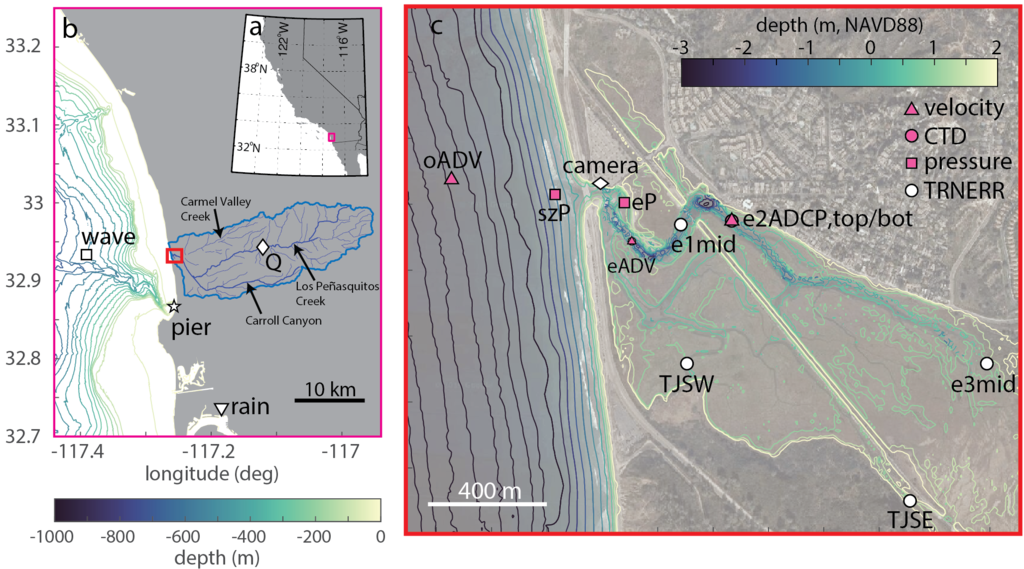
Figure 2. Los Peñasquitos Lagoon Hydrodynamic instrumentation, from Harvey et al. (accepted). Location of Los Peñasquitos Lagoon and instruments deployed. a.) California coastline with outline of panel b delineated in pink. b.) San Diego County coastline Los Peñasquitos Lagoon watershed and offshore bathymetry. USGS river discharge gauge (Q); SIO Pier (pier); CDIP wave buoy 100 (wave); and NCDC precipitation gauge (rain). Red outline delineates the region of panel c. c.) Los Peñasquitos Lagoon with instrument locations (white from TRNERR, pink are part of this project) overlain on marsh topography and bathymetry in teal. Estuary bathymetry is from UAV and towed ADCP, offshore bathymetry is from 1/3 arc-second NOAA San Diego Coastal DEM model referenced to NAVD88.
Project photos
- Lagoon mouth Pressure sensor installation
- Lagoon hydrodynamic sensor swap
- Lagoon mouth RTK survey
- Lagoon mouth UAV flight
- Lagoon mouth
- LPL from above
- mouth closure 2016
- mouth breaching 2016
- mouth breaching 2016
Key project results
- High resolution beach/estuary surveys (completed via hand-held RTK GPS, drone surveys, and liDAR) have been conducted quarterly for over 3 years producing a high quality coupled beach/estuary morphological change dataset. See Figure 3 for example flights and Figure 4 for difference maps.

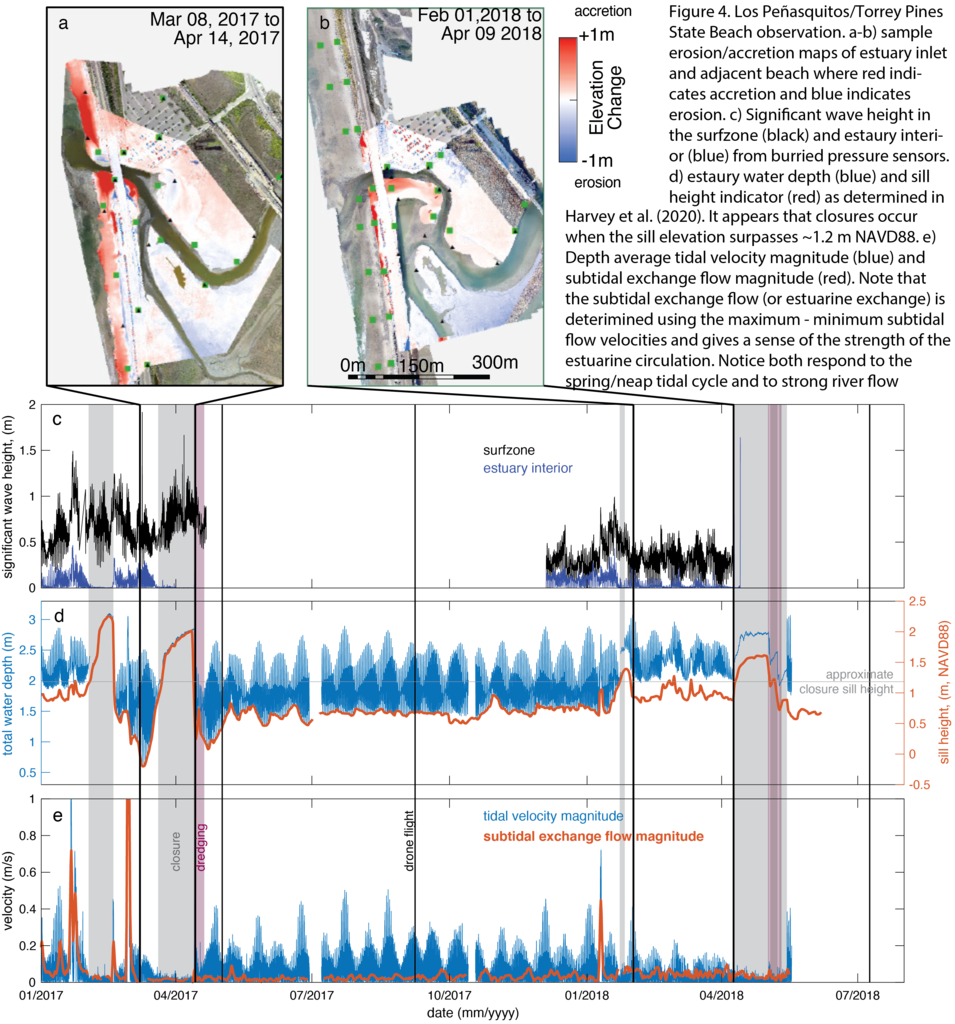
- In their present forms, CShore and XBeach are unable to accurately predict beach profile change on these typical southern California beaches, but when calibrated may provide qualitatively useful beach face erosion estimates (Kalligeris et al., 2020).

Figure. 5, from Kallegeris et al. (2020, Fig. 6). Section-averaged calibrated-XBeach (red), default-XBeach (black), Atlantic-CShore (blue), and Pacific-CShore (teal) fit measures for each event: skill score (BSS) of the bed elevation Eq. (2) and beach-elevation-change error (BECE) of the upper beach volume Eq. (3). Bars indicate each section’s minimum and maximum values. Circles in BSS plots are section median values. BECE values exceeding 2 are displayed as 2. Green background designates the event for which XBeach parameters were calibrated and blue background designates events for which the fit measures were calculated through upper beach measurements (as opposed to full beach profiles used for all other events).
- Water levels inside perennially open estuaries mirrored ocean water levels, while those inside intermittently closed estuaries (ICEs) exhibited enhanced higher-high water levels during large waves, and tides were truncated at low tides due to a wave-built sand sill at the mouth, resulting in elevated detided water levels (Harvey et al., 2020).
- The predominance of large significant wave height approaching the mouth at an angle perpendicular to the shoreline led to the most significant mouth accretion (see Figure 4).
- The impact on adjacent beaches has been varied; in the surveys shown in Figure 4, the adjacent beaches were also accreting, while in the aerial lidar dataset analyzed as part of this work (Young et al., 2018) the estuary inlet accreted while the adjacent beach eroded.
- ICEs closed when sufficient wave-driven sand accretion formed a barrier berm across the mouth separating the estuary from the ocean (Harvey et al., 2020)
- A sill-height metric to quantify estuary mouth sill height was determined using lower-low estuary water levels adjusted to a fixed vertical datum (Harvey et al., 2020) as validated in Figure 6 below, and used in Figure 4 above.

Figure 6. Sill height metric, reproduced from Harvey et al, (2020), Figure 6. (a) Tidal water level of Los Peñasquitos Lagoon (red) and lower-low water level (dark green). Major precipitation events (light blue, dashed) and mouth dredging events (gray, dashed) are marked with vertical lines. Dots indicate mouth state changes to closed (filled) or open (open). Gray shading indicates closed periods. (b) Lower-low water level (as in (a)) and average elevation of beach (light blue) and estuary (dark blue) areas determined from detailed topo-bathymetric surveys.
- During the 2015–2016 El Niño, a greater number of Southern California ICEs closed than during a typical year and ICEs that close annually experienced longer than normal closures (Harvey et al., 2020)
- Wave observations near the estuary inlet show that wave energy inside the inlet, which contributes to sill accretion, is dependent on water level relative to the sill height and has a tidal variation due to wave-current interactions (Harvey et al., accepted). See Figure 7.

Figure 7. IG Wave Height Reduction in Inlet, reproduced from Harvey. et al. (accepted), Fig. 5. All available open period data in a 2-D histogram of the water level height above the sill (water level offshore minus the lower-lower water level at eP such that values > 0 indicate the offshore water level is above the sill) against depth-averaged currents at e2 (where [u]>0 indicates a flood tide) where the size of the dot indicates the number of samples in each bin. The dot is colored by the average wave height reduction for all data that is in each bin. The wave height reduction is defined as the percent of wave height inside the estuary inlet, eP, relative to the surfzone, szP (i.e., 100% times HIG at eP divided by HIG at szP) where the lightest yellow indicates that surfzone waves do not reach the inlet sensor and dark pink indicates that waves at eP are the same size as those in the surfzone. The estuary IG wave height is greatest compared to that in the surfzone (dark pink) when the offshore water level is high compared to the sill height and during strong flooding tides (upper-right quadrant).
- IG frequency oscillations dominate the energy inside the inlet due to the sill at the estuary mouth (Harvey et al., accepted)
- IG motions drive very strong (~1m/s) velocity oscillations inside the estuary which are directly linked to sediment transport (Harvey et al., accepted) and turbulent dissipation (Wheeler et al., in review).

Figure 8: Snapshot of wave-current interactions from Harvey et al. (accepted) Fig. 6. a.) 30-min average velocity data at ADV ~.4 km upstream from estuary mouth (eADV). Blue (red) fill indicates outflowing (inflowing) velocity at eADV. b.) 30-minute averaged water level at eP (gray), eADV (black), and e2 (blue). c.) Raw water level minus 30-minute averaged water level at eP, eADV, and e2. eP sampled at 2 Hz; eADV sampled at 8 Hz; e2 sampled at 0.5 Hz. d.) uncalibrated turbidity voltage (thus qualitative) from optical backscatter sensor. Deployment occurred during the low tide through the lower-high and subsequent low.
- During open, low sill conditions, circulation and stratification are consistent with stratification-induced periodic straining and subtidal exchange varies with the fortnightly cycle as observed in many classical estuaries. However, as the sill grows, tidal circulation weakens and becomes strongly sheared and the subtidal exchange no longer scales with a classical theoretical pressure-friction balance.
- A preliminary realistic numerical model has been developed that includes tides, waves, river flow, and atmospheric forcing.


